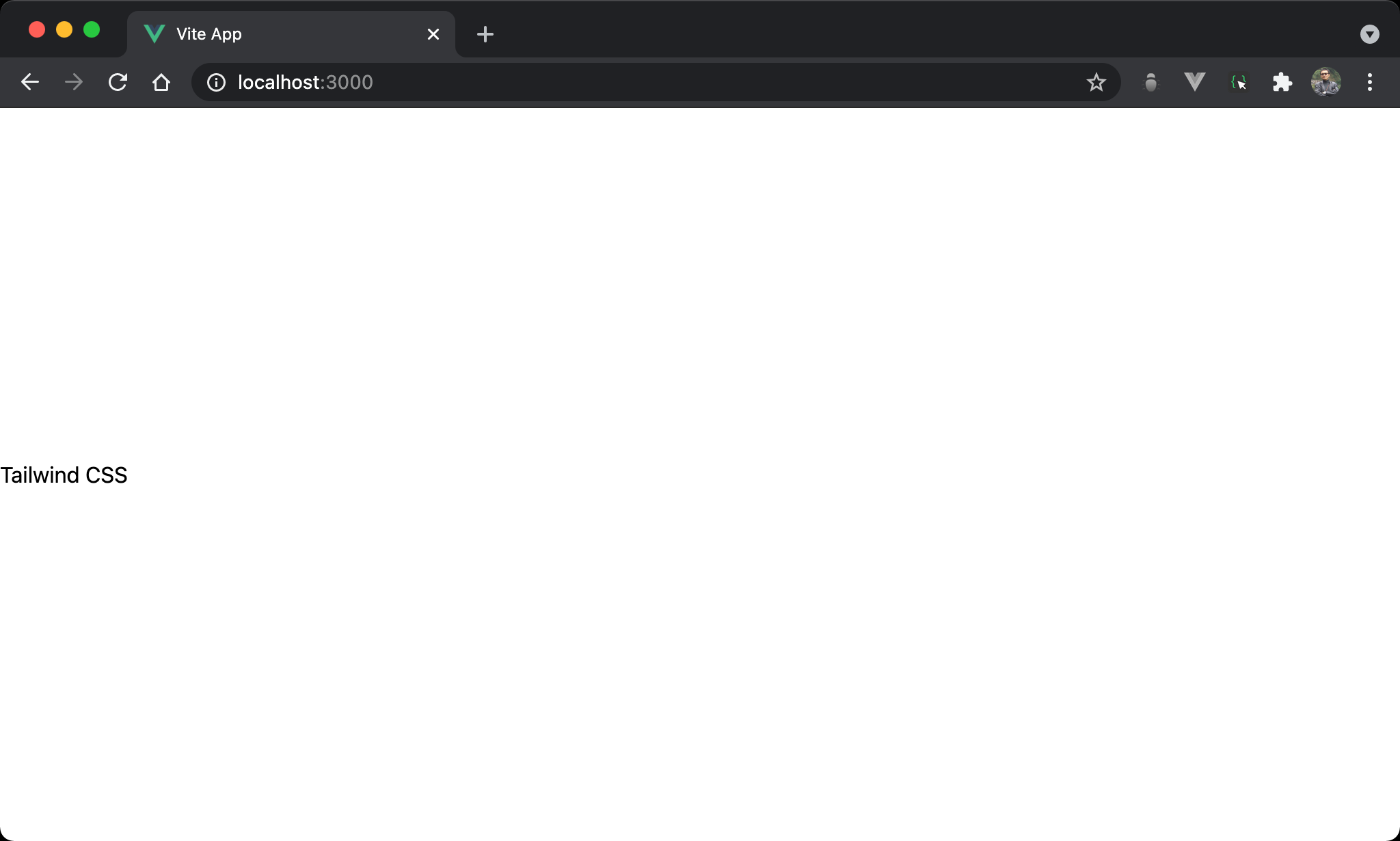垂直置中為實務上常見需求,Tailwind CSS 可由多種方式實現。
Version
Tailwind CSS 2.1.1
m-auto

Tailwind CSS 垂直置中,在子層 item 使用 m-auto 處理。
<template>
<div class="h-screen flex">
<div class="my-auto">
Tailwind CSS
</div>
</div>
</template>
第 2 行
<div class="h-screen flex">
設定父層 box style:
h-screen:要設定垂直置中,因此要設定父層 box 高度flex:使用flex令子層 item 根據 content 內縮
第 3 行
<div class="my-auto">
設定子層 item style:
my-auto:因為父層 box 有設定高度,因此子層 item 可自動調整上下 margin 而垂直置中
Flexbox
justify-between

Flexbox 亦有多種方式可垂直置中,先討論從父層 box 處理。
<template>
<div class="flex flex-col justify-between h-screen">
<div/>
<div>Tailwind CSS</div>
<div/>
</div>
</template>
子層使用 3 個 item,兩旁為 dummy div。
設定父層 box style:
flex:子層 item 使用 Flexbox 排列flex-col:設定 main axis 為 columnjustify-between:原本為將剩餘高度自動平分給 item 間剩餘空間,因為兩側 dummy div 沒有高度,平分剩餘空間後CSS看起來像垂直置中h-screen: 設定 box 高度
justify-around

Tailwind CSS 垂直置中,改用 justify-around 實現。
<template>
<div class="flex flex-col justify-around h-screen">
Tailwind CSS
</div>
</template>
設定父層 box 的 style:
flex:子層 item 使用 Flexbox 排列flex-col:設定 main axis 為 columnjustify-around:原本與justify-between一樣將剩餘高度自動平分給 item 間剩餘空間,但不同的是justify-around會考慮 item 的上下空間,因此平分後看起來Tailwind CSS像垂直置中h-screen:設定 box 高度
justify-evenly

Tailwind CSS 垂直置中,改用 justify-evenly 實現。
<template>
<div class="flex flex-col justify-evenly h-screen">
Tailwind CSS
</div>
</template>
設定父層 box 的 style:
flex:子層 item 使用 Flexbox 排列flex-col:設定 main axis 為 columnjustify-evenly:原本與justify-between一樣將剩餘高度自動平分給 item 間剩餘空間,但不同的是justify-around會考慮 item 的上下空間,因此平分後Tailwind CSS看起來像垂直置中h-screen:設定 box 高度
justify-around與justify-evenly差異是儘管包含 item 上下空間,但justify-evenly是真正evenly等高,但justify-arounditem 間空間會是前後高度的兩倍
justify-center

Tailwind CSS 垂直置中,改用 justify-center 實現。
<template>
<div class="flex flex-col justify-center h-screen">
Tailwind CSS
</div>
</template>
設定父層 box 的 style:
flex:子層 item 使用 Flexbox 排列flex-col:設定 main axis 為 columnjustify-center:直接將子層 item 垂直置中h-screen:設定 box 高度
items-center

Tailwind CSS 垂直置中,改用 items-center 實現。
<template>
<div class="flex items-center h-screen">
Tailwind CSS
</div>
</template>
設定父層 box 的 style:
flex:子層 item 使用 Flexbox 排列items-center:由於沒更改 flex-direction,因此目前 main axis 仍是 row,可使用items-center直接置中於 cross axis,相當於垂直置中h-screen:設定 box 高度
content-center

Tailwind CSS 垂直置中,改用 content-center 實現。
<template>
<div class="flex flex-wrap content-center h-screen">
Tailwind CSS
</div>
</template>
設定父層 box 的 style:
flex:子層 item 使用 Flexbox 排列flex-wrap:啟動換列機制,會抑制items-stretch預設 stretch 整個父層 box 高度,僅收縮成與 content 同高,因此 flex line 也收縮不再與父層 box 同高content-center:因為 flex line 不再與父層 box 同高,因此content-center才有機會以 flex line 對父層 box 垂直置中h-screen:設定 box 高度
flex-grow

Tailwind CSS 垂直置中,但在子層 item 處理。
<template>
<div class="flex flex-col h-screen">
<div class="flex-grow"/>
<div>Tailwind CSS</div>
<div class="flex-grow"/>
</div>
</template>
需使用三個子層 item。
第 2 行
<div class="flex flex-col h-screen">
設定父層 box 的 style:
display: flex:子層 item 使用 Flexbox 排列flex-direction: column:設定 main axis 為 columnh-screen:設定 box 高度
第 3 行
<div class="flex-grow"/>
flex-grow:表示空白部分剩餘 height 將由此<div>平分,因此看起來為垂直置中
fixed

Tailwind CSS 垂直置中,但使用 fixed 處理。
<template>
<div class="h-fit fixed top-0 bottom-0 m-auto">
Tailwind CSS
</div>
</template>
設定父層 box style:
h-fit:height 與 content 同高,但仍維持其 block 特性,讓m-auto有操作空間fixed:使用 fixed positiontop-0、bottom-0:要使用m-auto垂直置中,前提必須要有空間使其調整 margin,top-0於上側邊緣緊貼 browser,bottom-0於下側邊緣緊貼 browser,因此相當於架構出無形的矩形空間,只是受限於h-fit只顯示與 content 同高部分,剩下空間可由m-auto自由發揮而垂直置中m-auto:自動調整上下 margin 而垂直置中
absolute

Tailwind CSS 垂直置中,但使用 absolute 處理。
<template>
<div class="h-fit absolute top-0 bottom-0 m-auto">
Tailwind CSS
</div>
</template>
設定父層 box style:
h-fit:height 與 content 同高,但仍維持其 block 特性,讓m-auto有操作空間absolute:使用 absolute position,因為其父層皆沒設定定位,相當於定位在windowtop-0、bottom-0:要使用m-auto垂直置中,前提必須要有空間使其調整 margin,top-0於上側邊緣緊貼 browser,bottom-0於下側邊緣緊貼 browser,因此相當於架構出無形的矩形空間,只是受限於h-fit只顯示與 content 同高部分,剩下空間可由m-auto自由發揮而垂直置中m-auto:自動調整上下 margin 而垂直置中
relative

Tailwind CSS 垂直置中,但使用 relative 處理。
<template>
<div class="relative h-screen">
<div class="absolute top-1/2 transform -translate-y-1/2">
Tailwind CSS
</div>
</div>
</template>
第 2 行
<div class="relative h-screen">
設定父層 box style:
relative:父層 box 使用 relative position,子層absolute將以此層定位h-screen:設定 height 為整個 browser 高度
水平置中時不必設定
width,因為 block 預設就是佔據一整列,但height預設只是 content 高度,因此要特別設定才能垂直置中
第 3 行
<div class="absolute top-1/2 transform -translate-y-1/2">
設定子層 item style:
absolute:子層 item 使用 absolute positiontop-1/2:top座標為50%,此為item上側位置,並不算垂直置中transform:使用 transform-translate-y-1/2:將item上移本身 height 的50%,此時才算真正垂直置中
Conclusion
- Tailwind CSS 擁有多種方式垂直置中:
m-auto、Flexbox 、fixed、absolute與relative,可視實際需求靈活運用